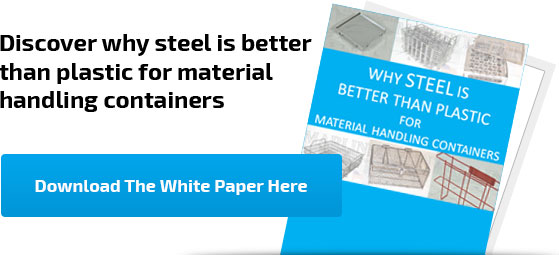 Marlin Steel has helped numerous manufacturers all over the world fulfill their parts washing basket needs. However, no two jobs are exactly alike. There are many different kinds of processes that a manufacturer might use to get their parts ready for final assembly/shipping, each one with different strengths and weaknesses.
Marlin Steel has helped numerous manufacturers all over the world fulfill their parts washing basket needs. However, no two jobs are exactly alike. There are many different kinds of processes that a manufacturer might use to get their parts ready for final assembly/shipping, each one with different strengths and weaknesses.
Which one is the best for your manufactured parts? The answer depends on a lot of things, such as what your parts are made of, and what kinds of residue or debris you’re trying to remove.
Here’s a short list of the different wash processes, and some strengths and weaknesses of each:
Standard
Many manufacturers rely on parts washing machines that use hot water or solvent mixtures sprayed onto parts to remove dirt and debris from their manufactured parts.
These machines operate in a manner similar to a common dishwasher, spraying down parts inside the machine with heated water or chemicals. The force of the solvents hitting the parts provides the mechanical action needed to scrub unwanted debris from the surface.
Strengths of this procedure include that it’s fairly easy to find equipment for it, and, depending on the solvents used, not very rough on most basket types.
However, parts with especially complicated shapes that have nooks or crannies might not come out completely clean in a single wash process, as the solvent spray might not reach these areas with full force.
Ultrasonic Parts Cleaning
Like standard parts washing, ultrasonic parts cleaning processes involve the use of specialized solvents to clean parts. However, rather than spraying on the solvent, parts are submerged in the liquid for cleaning.
Once submerged, the liquid is then agitated via the use of an ultrasound-generating transducer. The transducer vibrates the liquid solution at high frequencies, creating microscopic cavities. This cavitation process generates cavities and fills them in rapidly, creating the agitation needed to remove debris from the surface of a part.
An advantage of this process over standard washing is that it’s generally much better at removing stubborn stuck-on debris and other contaminants from the surface of a part than traditional washing techniques.
However, the process is much harsher on parts and baskets than traditional wash techniques. Because of this, wire baskets for ultrasonic parts washing tend to be made of thicker wires than ones for traditional parts machines. Additionally, more chemically-resistant materials are often used because of the complete submersion needed for this process.
Vapor Degreasing
Vapor degreasing is a very different process from the two listed above. This process relies on heating a solvent to a boil, and lowering the part to be cleaned into the vapor. Once the hot solvent hits the cooler material of the part, the solvent begins to cool and condense back into a liquid.
The liquefied solvent bonds with the contaminants on the part being cleaned and gravity takes care of the rest, pulling the liquid solvent back down into the degreasing chamber with the contaminants.
Advantages of vapor degreasing include that:
- It can be very economical with the use of solvent, as used solvent drips back into the degreaser for further use.
- It tends to be very effective at removing sludge and oil-based contaminants from parts.
However, there are a couple of disadvantages to vapor degreasing as well.
First, the process isn’t quite as effective as the methods listed above at removing metal shavings or other physical debris from parts, as there is very little mechanical action to force such insoluble contaminants free. As such, a secondary wash process may need to be used. Second, the strong solvents needed for this process can be very tough on materials after repeated exposure. Overall, vapor degreasing is a great process for removing sludge from parts, which is probably why Caterpillar uses this process for remanufacturing their used fuel cam shafts.
Sterilization Via Heat or Chemical Treatment
In the food and pharmaceuticals industries, it’s often necessary to make sure that not only are part surfaces free of dirt and debris, but that they have been thoroughly sterilized as well. Sterilization of parts can be performed through the use of intense heat, chemicals, or both.
The process of sterilization is rarely performed alone, but is rather used as a final wash process to complement some other wash procedure. As such, any washing basket designed to take the heat and/or chemicals used in the sterilization process also has to be able to take the rigors of the other wash process.
Which Process is Best?
Choosing the right process or combination of processes can be tough. Not only do you have to consider the effectiveness of each process at eliminating specific kinds of contaminants, but the factory footprint, solvent use, energy consumption, and maintenance requirements of each parts cleaning machine you need.
Ultimately, the best cleaning process is the one that gets the surface of your parts in the best condition for use with the lowest rate of causing damage to your manufactured parts.
Whichever parts cleaning process or processes that you use, having the right parts washing basket for the job is integral to ensuring that your parts come through the process in top shape.
For example, in ultrasonic parts cleaning processes, it’s often necessary to keep parts from rattling around during the cavitation process to prevent scratching. Or, you may need to use a highly corrosion-resistant material for your baskets because of a specific solvent used in your washing process so that your baskets don’t become corroded and misshapen.



.gif)


